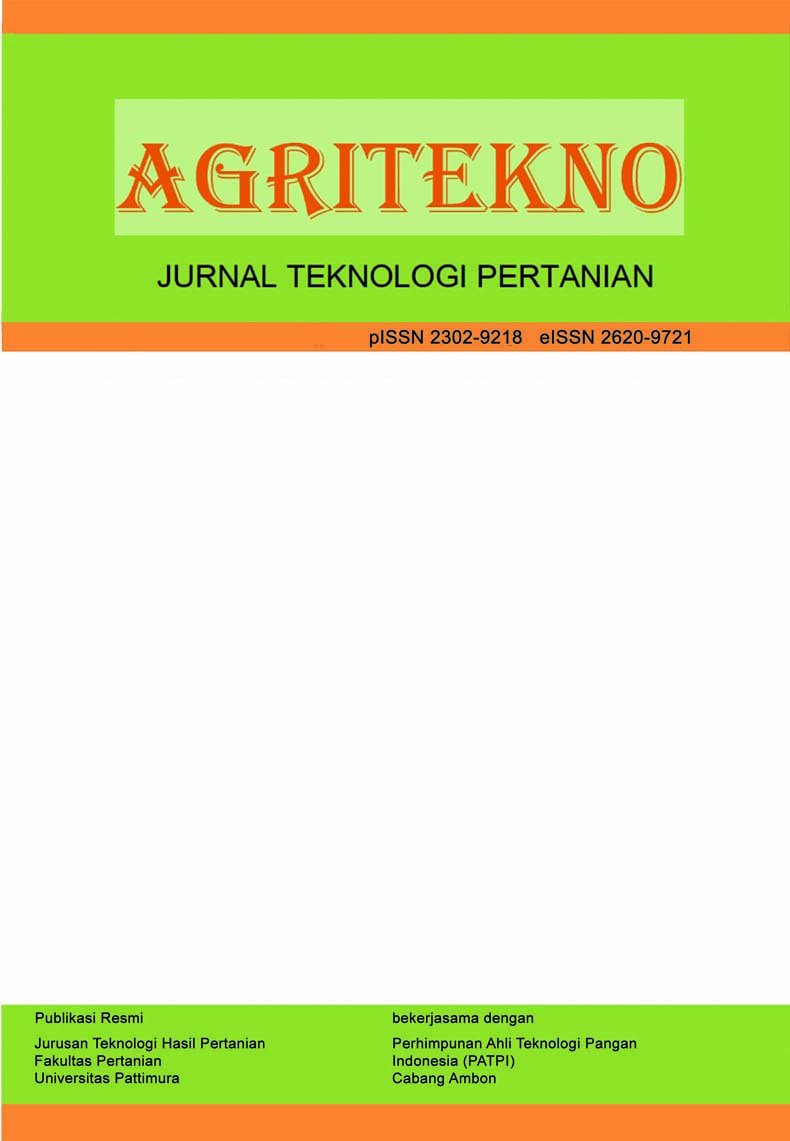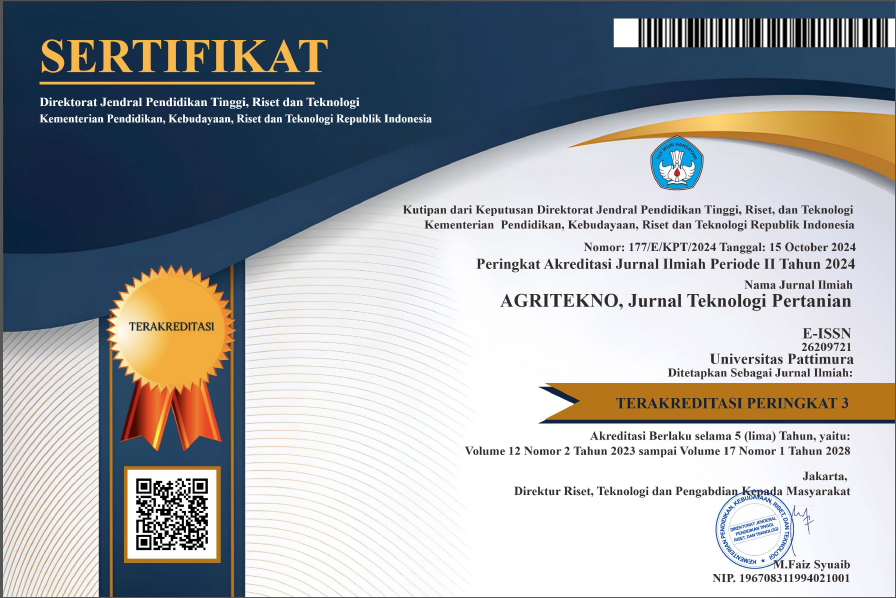Liang Teh Pontianak Kaya Antioksidan Pada Berbagai Formulasi Substitusi Massa Rasio Jahe Gamprit
Liang Tea Pontianak Rich in Antioxidants with Various of Formulations of Gamprit Ginger Mass Ratio Substitution
Abstract
Liang Tea Pontianak (LTP) is a rich antioxidant herbal tea composed of a mixture of several plant ingredients, including muje leaves (Dicliptera chinensis), oregano leaves (Origanum vulgare), pineapple shell leaves (Tradescantia spathacea), pandan leaves (Pandanus amaryllifolius), and aloe vera (Aloe vera chinensis). Adding ginger to Liang Tea Pontianak has not been explored, but the ginger mixture has an innovative, antioxidant-rich flavor in LTP. This research aimed to obtain the mass ratio of ginger substitution in the formulation that produces the best sensory and physicochemical characteristics of antioxidant-rich LTP. This study employed a Randomized Group Design with a single factor, comprising five treatment levels of ginger mass ratio substitution in LTP ((2:0), (1.9:0.1), (1.8:0.2), (1.7:0.3), and (1.6:0.4)) with five replications. The results showed that the best sensory and physicochemical characteristics of Liang Tea Pontianak with ginger substitution were obtained in the treatment of 1.8:0.2, which exhibited the best sensory test values for color 4,24 ± 0,83 (more liked), aroma 3.76 ± 0,97 (liked), and taste 3.56 ± 0,92 (liked). The physicochemical analysis yielded the following values: L* color (31.90 ± 2,08), a* color (3.20 ± 0,81), b* color (5.70 ± 0,53), total flavonoids 82.71 ± 6,16 mg QE/g, and antioxidant activity 78.90 ± 4,40%.
Downloads
References
Adawiah, Sukandar, D., & Muawanah, A. (2015). Aktivitas antioksidan dan kandungan komponen bioaktif sari buah namnam. Jurnal Kimia Valensi, 1(2), 130–136. https://doi.org/10.15408/jkv.v0i0.3155
Arifin, B., & Ibrahim, S. (2018). Struktur, bioaktivitas dan antioksidan flavonoid. Jurnal Zarah, 6(1), 21–29. https://doi.org/10.31629/zarah.v6i1.313
Banjarnahor, S. D. S., & Artanti, N. (2014). Antioxidant properties of flavonoids. Medical Journal Indonesia, 23(4), 239–244.
Bayliak, M. M., Burdyliuk, N. I., & Lushchak, V. I. (2016). Effects of pH on antioxidant and prooxidant properties of common medicinal herbs. Open Life Sciences, 11, 298–307. https://doi.org/10.1515/biol-2016-0040
Dewi, Y. S. K. (2022). The study of citrus peels (Citrus amblycarpa) mass ratio substitution on physicochemical of rich-antioxidant of liang tea. Jurnal Ilmu Kesehatan, 16(2), 241–248.
Dewi, Y. S. K., Purwayantie, S., Christian, F., Fadly, D., & Simamora, C. J. K. (2022). Phytochemicals, antioxidant activities, and toxicity evaluation of several fractions of Scorodocarpus borneensis Becc. leaves. Rasayan Journal of Chemistry, 15(1), 705–710. https://doi.org/10.31788/RJC.2022.1516580
Dewi, Y. S. K., Purwayantie, S., & Sutignya, T. C. W. A. (2021). Teknologi produksi isotonik kaya antioksidan berbasis lidah buaya-liang teh-madu hutan. Prosiding SAINTEK, 3, 585–592.
Florentina, D. V., Dewi, Y. S. K., & Priyono, S. (2023). Karakteristik mutu sensori dan kimia liang teh pontianak kaya antioksidan pada berbagai suhu pengeringan. Jurnal Al-Azhar Indonesia Seri Sains dan Teknologi, 8(1), 49. https://doi.org/10.36722/sst.v8i1.1432
Fortin, G. A., Asnia, K. K. P., & Ramadhani, A. S. (2021). Review: Minuman fungsional serbuk instan kaya antioksidan dari bahan nabati. Agrointek, 15(4), 984–991. https://doi.org/10.21107/agrointek.v15i4.8977
Ibrahim, A. M., Sriherfyna, F. H., & Yunianta. (2015). Pengaruh suhu dan lama waktu ekstraksi terhadap sifat kimia dan fisik pada pembuatan minuman sari jahe merah (Zingiber officinale var. Rubrum) dengan kombinasi penambahan madu sebagai pemanis. Jurnal Pangan Dan Agroindustri, 3(2), 530–541.
Irianti, T., Ugm, S., Nuranto, S., & Kuswandi, K. (2017). Antioksidan. Yogyakarta: Universitas Gadjah Mada.
Ishtiaque, S., Naz, S., Soomro, N., Siddiqui, R., & Khan, K. (2015). Antioxidant activity and total phenolics content of extracts from Murraya koenigii (Curry leaves), Laurus nobilis (Bay leaves), and Camellia sinensis (Tea). Journal of Engineering, Science and Technology, 14(2), 20–25.
Meilgaard, M., Civille, G. V., & Carr, T. (1999). Sensory Evaluation Techniques. In CRC Press : USA (3rd ed.).
Mudin, M. U., Muaida, Saputra, M. R., Lestari, K. C., Khotimah, K., & Janah, M. (2021). Inovasi minuman ekstrak jahecang untuk meningkatkan kesehatan masyarakat di PKK Desa Pasir Barat Kabupaten Tangerang. Jurnal Pengabdian Sosial, 1(2), 223–230.
Muzaki, D., & Wahyuni, R. (2015). Pengaruh penambahan gingger kering (Zingiber officinale) terhadap mutu dan daya terima teh herban daun Afrika Selatan (Vernonia amygdalina). Jurnal Teknologi Pangan, 6(2), 67–75. https://doi.org/10.35891/tp.v6i2.470
Palupi, M. R., & Widyaningsih, T. D. (2015). Pembuatan minuman fungsional liang teh daun salam (Eugenia polyantha) dengan penambahan filtrat jahe dan filtrat kayu secang. Jurnal Pangan dan Agroindustri, 3(4), 1458–1464.
Pratiwi, I., & Wiadnyani, AA. (2018). Aktivitas antioksidan dan kandungan flavonoid minuman ready to serve dari ekstrak daun cem-cem, daun pegagan dan daun katuk. Jurnal Media Ilmiah Teknologi Pangan, 5(1), 19–26.
Ramadhanti, D. D., Priyanto, B., & Rahmi, A. (2023). Pembuatan sirup bunga rosella (Hibiscus sabdariffa L.) dengan kayu manis (Cinnamomum burmannii). Agritekno: Jurnal Teknologi Pertanian, 12(1), 33–39. https://doi.org/10.30598/jagritekno.2023.12.1.33
Redha, A. (2010). Flavonoid: Struktur, sifat antioksidatif dan peranannya dalam sistem biologis. Jurnal Berlin, 9(2), 196–202. https://doi.org/10.1186/2110-5820-1-7
Rohiqi, H., Yusasrini, N. L. A., & Diah Puspawati, G. (2021). Pengaruh tingkat ketuaan daun terhadap karakteristik teh herbal matcha tenggulun (Protium javanicum Burm. F.). Jurnal Ilmu Dan Teknologi Pangan (ITEPA), 10(3), 345–356. https://doi.org/10.24843/itepa.2021.v10.i03.p03
Sari, R. P., & Rahayuningsih, H. M. (2014). Pengaruh pemberian jahe merah (Zingiber officinale Var Rubrum) terhadap kadar kolesterol total wanita dislipidemia. Journal of Nutrition College, 3(4), 798–806.
Shannon, E., Jaiswal, A. K., & Abu-Ghannam, N. (2018). Polyphenolic content and antioxidant capacity of white, green, black, and herbal teas: A kinetic study. Journal Food Research, 2(1), 1–11. https://doi.org/10.26656/fr.2017.2(1).117
Sinaga, A. S. (2019). Segmentasi ruang warna L*a*b. Jurnal Mantik Penusa, 3(1), 43–46.
Surachman, & Dewi, Y. S. K. (2022). Ginger (Zingiber officinale) mass ratio on physicochemical and sensory characteristics of liang tea. Gorontalo Agriculture Technology Journal, 5(2), 63–76.
Suter, I. K. (2013). Pangan fungsional dan prospek pengembangannya. Trends in Food Science & Technology, 6(2), 1–17.
Tambun, R., Limbong, H. P., Pinem, C., & Manurung, E. (2017). Pengaruh ukuran partikel, waktu dan suhu pada ekstraksi fenol dari lengkuas merah. Jurnal Teknik Kimia USU, 5(4), 53–56. https://doi.org/10.32734/jtk.v5i4.1555
Tarwendah, I. P. (2017). Studi komparasi atribut sensori dan kesadaran merek produk pangan. Jurnal Pangan Dan Agroindustri, 5(2), 66–73.
Topuz, A., Dinçer, C., Torun, M., Tontul, I., Şahin-Nadeem, H., Haznedar, A., & Özdemir, F. (2014). Physicochemical properties of turkish green tea powder: effects of shooting period, shading, and clone. Turkish Journal of Agriculture and Forestry, 38(2), 233–241. https://doi.org/10.3906/tar-1307-17
Wang, L., Fan, S., Wang, X., Wang, X., Yan, X., Shan, D., Xiao, W., Ma, J., Wang, Y., Li, X., Xu, X., & She, G. (2019). Physicochemical aspects and sensory profiles as various potential factors for comprehensive quality assessment of Nü-Er-Cha produced from Rhamnus heterophylla Oliv. Molecules, 24, 1–16. https://doi.org/10.3390/molecules24183211
Widiyana, I. G., Yusa, N. M., & Sugitha, I. M. (2021). Pengaruh penambahan bubuk jahe emprit (Zingiber officinale var. Amarum) terhadap karakteristik teh celup herbal daun ciplukan (Physalis angulata L.). Jurnal Ilmu Dan Teknologi Pangan, 10(1), 45–56. https://doi.org/10.24843/itepa.2021.v10.i01.p05
Wijaya, D. R., Paramitha, M., & Putri, N. P. (2019). Ekstraksi oleoresin jahe gajah dengan metode sokletasi. Jurnal Konversi, 8(1), 9–16.
Yakubu, O., Nwodo, O. F., Joshua, P., Ugwu, M., Odu, A., & Okwo, F. (2014). Fractionation and determination of total antioxidant capacity, total phenolic and total flavonoids contents of aqueous, ethanol and n-hexane extracts of Vitex doniana leaves. African Journal of Biotechnology, 13(5), 693–698. https://doi.org Alstonia scholaris /10.5897/ajb2013.13225
Zuraida, Z., Sulistiyani, Sajuthi, D., & Suparto, I. H. (2017). Fenol, flavonoid, dan antivitas antioksidan pada ekstrak kulit batang pulai (R.Br). Jurnal Penelitian Hasil Hutan, 35(3), 211–219. https://doi.org/10.20886/jphh.2017.35.3.211-219
Copyright (c) 2024 The Author(s)

This work is licensed under a Creative Commons Attribution-ShareAlike 4.0 International License.
Authors who publish with this journal agree to the following terms:
- Authors retain copyright and grant the journal the right of first publication with the work simultaneously licensed under a Creative Commons Attribution License that allows others to share the work with an acknowledgement of the work's authorship and initial publication in this journal.
- Authors are able to enter into separate, additional contractual arrangements for the non-exclusive distribution of the journal's published version of the work (e.g., post it to an institutional repository or publish it in a book), with an acknowledgement of its initial publication in this journal.
- Authors are permitted and encouraged to post their work online (e.g., in institutional repositories or on their website) prior to and during the submission process, as it can lead to productive exchanges, as well as earlier and greater citation of published work (See The Effect of Open Access).









